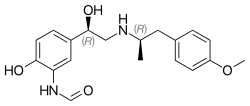From Wikipedia, the free encyclopedia
Arformoterol |
 |
|
| Trade names | Brovana |
|---|
| AHFS/Drugs.com | Monograph |
|---|
| MedlinePlus | a602023 |
|---|
| License data |
|
|---|
Routes of
administration | Inhalation solution for nebuliser |
|---|
| ATC code | |
|---|
|
| Legal status |
|
|---|
|
| Protein binding | 52–65% |
|---|
| Elimination half-life | 26 hours |
|---|
|
N-[2-hydroxy-5-[(1R)-1-hydroxy-2-[[(2R)-1-(4-methoxyphenyl) propan-2-yl]amino]ethyl] phenyl]formamide
|
| CAS Number | |
|---|
| PubChem CID | |
|---|
| IUPHAR/BPS | |
|---|
| DrugBank | |
|---|
| ChemSpider | |
|---|
| UNII | |
|---|
| ChEBI | |
|---|
| ChEMBL | |
|---|
| CompTox Dashboard (EPA) | |
|---|
|
| Formula | C19H24N2O4 |
|---|
| Molar mass | 344.411 g·mol−1 |
|---|
InChI=1S/C19H24N2O4/c1-13(9-14-3-6-16(25-2)7-4-14)20-11-19(24)15-5-8-18(23)17(10-15)21-12-22/h3-8,10,12-13,19-20,23-24H,9,11H2,1-2H3,(H,21,22)/t13-,19+/m1/s1  Y YKey:BPZSYCZIITTYBL-YJYMSZOUSA-N  Y Y
|
 N N Y (what is this?) (verify) Y (what is this?) (verify) |
Arformoterol is a long-acting β2 adrenoreceptor agonist (LABA) indicated for the treatment of chronic obstructive pulmonary disease (COPD). It is sold by Sunovion, under the trade name Brovana, as a solution of arformoterol tartrate to be administered twice daily (morning and evening) by nebulization.[1]
It is the active (R,R)-(−)-enantiomer of formoterol and was approved by the United States Food and Drug Administration (FDA) on October 6, 2006 for the treatment of COPD.
References
External links
|
|---|
| α1 | | Agonists | |
|---|
| Antagonists |
- Abanoquil
- Ajmalicine
- Alfuzosin
- Anisodamine
- Anisodine
- Atiprosin
- Atypical antipsychotics (e.g., brexpiprazole, clozapine, olanzapine, quetiapine, risperidone)
- Benoxathian
- Beta blockers (e.g., adimolol, amosulalol, arotinolol, carvedilol, eugenodilol, labetalol)
- Buflomedil
- Bunazosin
- Corynanthine
- Dapiprazole
- Domesticine
- Doxazosin
- Ergolines (e.g., acetergamine, ergotamine, dihydroergotamine, lisuride, nicergoline, terguride)
- Etoperidone
- Fenspiride
- Hydroxyzine
- Indoramin
- Ketanserin
- L-765,314
- mCPP
- Mepiprazole
- Metazosin
- Monatepil
- Moxisylyte
- Naftopidil
- Nantenine
- Neldazosin
- Niaprazine
- Niguldipine
- Pardoprunox
- Pelanserin
- Perlapine
- Phendioxan
- Phenoxybenzamine
- Phentolamine
- Phenylpiperazine antidepressants (e.g., hydroxynefazodone, nefazodone, trazodone, triazoledione)
- Piperoxan
- Prazosin
- Quinazosin
- Quinidine
- Silodosin
- Spegatrine
- Spiperone
- Talipexole
- Tamsulosin
- Terazosin
- Tiodazosin
- Tolazoline
- Tetracyclic antidepressants (e.g., amoxapine, maprotiline, mianserin)
- Tricyclic antidepressants (e.g., amitriptyline, clomipramine, doxepin, imipramine, trimipramine)
- Trimazosin
- Typical antipsychotics (e.g., chlorpromazine, fluphenazine, loxapine, thioridazine)
- Urapidil
- WB-4101
- Zolertine
|
|---|
|
|---|
| α2 | | Agonists | |
|---|
| Antagonists |
- 1-PP
- Adimolol
- Amesergide
- Aptazapine
- Atipamezole
- Atypical antipsychotics (e.g., asenapine, brexpiprazole, clozapine, lurasidone, olanzapine, paliperidone, quetiapine, risperidone, zotepine)
- Azapirones (e.g., buspirone, gepirone, ipsapirone, tandospirone)
- BRL-44408
- Buflomedil
- Cirazoline
- Efaroxan
- Esmirtazapine
- Fenmetozole
- Fluparoxan
- Idazoxan
- Ketanserin
- Lisuride
- mCPP
- Mianserin
- Mirtazapine
- NAN-190
- Pardoprunox
- Phentolamine
- Phenoxybenzamine
- Piperoxan
- Piribedil
- Rauwolscine
- Rotigotine
- Setiptiline
- Spegatrine
- Spiroxatrine
- Sunepitron
- Terguride
- Tolazoline
- Typical antipsychotics (e.g., chlorpromazine, fluphenazine, loxapine, thioridazine)
- Yohimbine
|
|---|
|
|---|
| β | |
|---|
|


